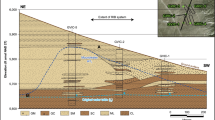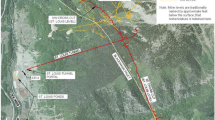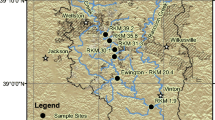Abstract
The vast occurrence of mine drainage worldwide, documented in descriptive studies, presents a staggering challenge for remediation. Any tool that can move beyond descriptive study and helps to evaluate options for remediation in a way that maximizes improvements to the water quality of streams and minimizes cost of remediation could save valuable resources and time. A reactive solute transport model, calibrated from two detailed mass-loading studies in Little Cottonwood Creek (LCC), Utah, provides a tool to evaluate remediation options. Metal loading to LCC is dominated by discharge from two mine drainage tunnels. Discharge from an upstream tunnel has been treated by a fen to reduce metal loading. Discharge from the downstream tunnel (WDT) can be controlled because of a bulkhead that creates a mine pool. Simulations of remedial options for three compliance locations suggest that the water-quality standards for Cu and Zn at upstream and downstream compliance locations are met using various combinations of fen treatment and WDT regulation, but the complete compliance at the middle compliance location requires the highest level of fen treatment and the greatest regulation of WDT discharge. Reactive transport modeling is an useful tool for the evaluation of remedial alternatives in complex natural systems, where multiple hydrologic and geochemical processes determine metal fate.





Similar content being viewed by others
References
Allison JD, Brown DS, Novo-Gradac KJ (1991) MINTEQA2, a geochemical assessment data base and test cases for environmental systems: version 3.0 user’s manual. U.S. EPA, Athens
Anderson PR, Benjamin MM (1990) Modeling adsorption in aluminum-iron binary oxide suspensions. Environ Sci Technol 24:1586–1592. doi:10.1021/es00080a020
Ball JW, Runkel RL, Nordstrom DK (2004) Evaluating remedial alternatives for the Alamosa River and Wightman Fork, near the Summitville Mine, Colorado. In: Zannetti P (ed) Environmental sciences and environmental computing. The EnviroComp Institute,
Bencala KE, McKnight DM (1987) Identifying in-stream variability: sampling iron in an acidic stream. In: Averett RC, McKnight DM (eds) Chemical quality of water and the hydrologic cycle. Lewis Publishers, Inc., Chelsea, MI, pp 255–269
Besser JM, Allert AL, Hardesty DK, May TW, Leib KJ (1999) Seasonal variation in toxicity of streams affected by acid mine drainage. In: 20th Annual Meeting, Philadelphia, Penn., November 14–19, 1999. Society of Environmental Toxicity and Chemistry (SETAC), pp 285
Broshears RE, Runkel RL, Kimball BA, Bencala KE, McKnight DM (1996) Reactive solute transport in an acidic stream: experimental pH increase and simulation of controls on pH, aluminum, and iron. Environ Sci Technol 30:3016–3024. doi:10.1021/es960055u
Brown E, Skougstad MW, Fishman MJ (1970) Methods for collection and analysis of water samples for dissolved minerals and gases. U.S. Geological Survey Techniques of Water-Resources Investigation Book 5, Chapter A1
Choi J, Harvey JW, Conklin M (2000) Characterizing multiple timescales of stream and storage zone interaction that affect solute fate and transport in streams. Water Resour Res 36:1511–1518. doi:10.1029/2000WR900051
Dzombak DA, Morel FMM (1990) Surface complexation modeling: hydrous ferric oxide. Wiley, New York
Gerner LJ, Rossi FJ, Kimball BA (2001) Selected hydrologic data for Little Cottonwood Creek, Salt Lake County, Utah, September 1998. U.S. Geological Survey Open-File Report 01-38
Jensen SF, Karimi R (2001) Rocky mountain headwaters mine waste initiative, Alta Wetlands Fen Pilot Project, Interim Report V, 2001 Monitoring Season. Salt Lake County Engineering Division, Salt Lake City
Kilpatrick FA, Cobb ED (1985) Measurement of discharge using tracers. U.S. Geological Survey Techniques of Water-Resources Investigations Book 3, Chapter A16
Kimball BA, McKnight DM, Wetherbee GA, Harnish RA (1992) Mechanisms of iron photoreduction in a metal-rich, acidic stream (St Kevin, Gulch, Colorado, U.S.A.). Chem Geol 96:227–239. doi:10.1016/0009-2541(92)90130-W
Kimball BA, Broshears RE, Bencala KE, McKnight DM (1994) Coupling of hydrologic transport and chemical reactions in a stream affected by acid mine drainage. Environ Sci Technol 28:2065–2073. doi:10.1021/es00061a014
Kimball BA, Callender E, Axtmann EV (1995) Effects of colloids on metal transport in a river receiving acid mine drainage, upper Arkansas River, Colorado. USA Appl Geochem 10:285–306. doi:10.1016/0883-2927(95)00011-8
Kimball BA, Bencala KE, Runkel RL (2000) Quantifying effects of metal loading from mine drainage. In: Fifth International Conference on Acid Rock Drainage, May 13–15, 2000, Denver, Colo. Society for Mining, Metallurgy, and Exploration, Inc., Englewood, Colo., pp 1381–1389
Kimball BA, Runkel RL, Gerner LJ (2001) Quantification of mine-drainage inflows to Little Cottonwood Creek, Utah, using a tracer-injection and synoptic-sampling study. Environ Geol 40:1390–1404. doi:10.1007/s002540100320
Kimball BA, Runkel RL, Walton-Day K, Bencala KE (2002) Assessment of metal loads in watersheds affected by acid mine drainage by using tracer injection and synoptic sampling: Cement Creek, Colorado, USA. Appl Geochem 17:1183–1207. doi:10.1016/S0883-2927(02)00017-3
Kimball BA, Runkel RL, Walton-Day K (2003) Use of field-scale experiments and reactive solute-transport modelling to evaluate remediation alternatives in streams affected by acid mine drainage. In: Jambor JL, Blowes DW, Ritchie AIM (eds) Environmental aspects of mine wastes. Mineralogical Association of Canada, British Columbia, pp 261–282
Kimball, BA, Johnson, KK, Runkel, RL, Steiger, JI (2004) Quantification of metal loading to Silver Creek through the Silver Maple Claims area, Park City, Utah, May 2002. U.S. Geological Survey Water-Resources Investigations Report 03-4296
Kimball BA, Walton-Day K, Runkel RL (2007) Quantification of metal loading by tracer injection and synoptic sampling, 1996–2000. In: Church SE, von Guerard PB, and Finger SE (eds) Integrated investigations of environmental effects of historical mining in the Animas River watershed, San Juan County, Colorado. U.S. Geological Survey, chap E9, pp 417–495
Leib KJ, Mast MA, Wright WG (2003) Using water-quality profiles to characterize seasonal water quality and loading in the upper Animas River Basin, Southwestern Colorado. U.S. Geological Survey Water-Resources Investigations Report 02-4230
Miller Shepherd (2002) Total maximum daily load for dissolved zinc in the Little Cottonwood Creek. Utah Division of Water Quality, Salt Lake City
Parkhurst DL, Appelo CAJ (1999) User’s guide to PHREEQC (Version 2)—a computer program for speciation, batch-reaction, one-dimensional transport, and inverse geochemical calculations. U.S. Geological Survey Water-Resources Investigation Report 99-4259
Runkel RL (1998) One-dimensional transport with inflow and storage (OTIS): a solute transport model for streams and rivers. U.S. Geological Survey Water-Resources Investigations 98-4018
Runkel RL, Kimball BA (2002) Evaluating remedial alternatives for an acid mine drainage stream: application of a reactive transport model. Environ Sci Technol 36:1093–1101. doi:10.1021/es0109794
Runkel RL, Kimball BA (2007) A simulation-based approach for estimating premining water quality: red Mountain Creek, Colorado. Appl Geochem 22:1899–1918. doi:10.1016/j.apgeochem.2007.03.054
Runkel RL, Bencala KE, Broshears RE, Chapra SC (1996a) Reactive solute transport in streams 1, Development of an equilibrium-based model. Water Resour Res 32:409–418. doi:10.1029/95WR03106
Runkel RL, McKnight DM, Bencala KE, Chapra SC (1996b) Reactive solute transport in streams 2 Simulation of a pH modification experiment. Water Resour Res 32:419–430. doi:10.1029/95WR03107
Runkel RL, Kimball BA, McKnight DM, Bencala KE (1999) Reactive solute transport in streams: a surface complexation approach for trace metal sorption. Water Resour Res 35:3829–3840. doi:10.1029/1999WR900259
Smith KS (1999) Metal sorption on mineral surfaces: an overview with examples relating to mineral deposits. In: Plumlee G, Logsdon MJ (eds) The environmental geochemistry of mineral deposits part A: processes, techniques, and health issues. Society of Economic Geologists, Littleton, pp 161–182
To TB, Nordstrom DK, Cunningham KM, Ball JW, McCleskey RB (1998) A new method for the direct determination of dissolved Fe(III) concentration in acid mine waters. Environ Sci Technol 33:807–813. doi:10.1021/es980684z
Toner B, Manceau A, Marcus MA, Millet DB, Sposito G (2005) Zinc sorption by a bacterial biofilm. Environ Sci Technol 39:8288–8294. doi:10.1021/es050528+
Utah Department of Administrative Services (2005) Standards of quality for waters of the state. Division of Administrative Rules, http://www.rules.utah.gov/publicat/code/r314/r317-002.htm. Accessed 7 April 2005
Walton-Day K, Paschke SS, Runkel RL, Kimball BA (2007) Using the OTIS solute transport model to evaluate remediation scenarios in Cement Creek and the upper Animas River. In: Church SE, von Guerard PB, and Finger SE (eds) Integrated investigations of environmental effects of historical mining in the Animas River watershed, San Juan County, Colorado. U.S. Geological Survey, chap E24, pp 973–1028
Ward JR, Harr CA (1990) Methods for collection and processing of surface-water and bed-material samples for physical and chemical analyses. U.S. Geological Survey Open-File Report 89-140
Wilkowske CD, Allen DV, Phillips JV (2003) Drought conditions in Utah during 1999–2002: a historical perspective. U.S. Geological Survey Fact Sheet 037-03
Acknowledgments
This work was done in cooperation with Salt Lake County Engineering Division and with support from the U.S. Geological Survey Toxic Substances Hydrology Program. The manuscript benefited from helpful reviews by Pierre Glynn and Terry Kenney of the U.S. Geological Survey.
Author information
Authors and Affiliations
Corresponding author
Electronic supplementary material
Below is the link to the electronic supplementary material.
Rights and permissions
About this article
Cite this article
Kimball, B.A., Runkel, R.L. Evaluating remediation alternatives for mine drainage, Little Cottonwood Creek, Utah, USA. Environ Earth Sci 60, 1021–1036 (2010). https://doi.org/10.1007/s12665-009-0240-0
Received:
Accepted:
Published:
Issue Date:
DOI: https://doi.org/10.1007/s12665-009-0240-0




